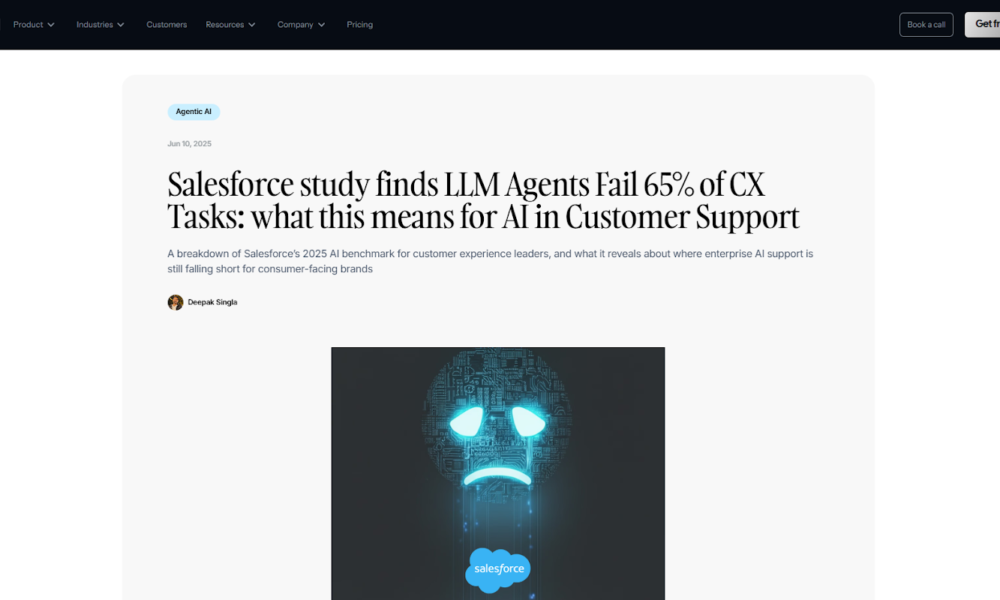Agentic AI Is Stalling At 65% Resolution: Here’s The Blueprint To Close The Gap

Key takeaways
- Enterprise “agentic” chatbots still solve only 35–65% of customer issues without human help, despite larger models.
- Three hidden chokepoints — brittle memory, misrouted tools, and overzealous guardrails — explain most failures.
- A five-step blueprint (continuous eval, scoped memory, dynamic routing, layered guardrails, feedback loops) lifts resolution into the high-80s at comparable cost.
- A Salesforce 2025 benchmark confirms the plateau; our own pilots show how to break it.
- For a data-driven teardown of the Salesforce numbers, see “why most LLM agents still fail multi-turn CX flows” in Fini AI’s deep dive here.
Why it matters
Agentic AI promised to shrink support costs and boost CSAT, but real-world numbers keep stalling at a coin-flip: roughly one in three conversations still require a human rescue, according to field reports VentureBeat has highlighted all year. At scale, that plateau erodes ROI and frustrates customers who now expect AI to get it right.
Salesforce’s own 2025 benchmark underscored the problem: 65% resolution on average across retail, travel, and fintech use cases; barely above last year’s numbers. You can explore how Fini AI approaches the problem across different verticals on their site.
Where agentic AI breaks down
ChokepointSymptom in productionWhy it happensFragile memoryBot forgets order details mid-chatContext window overflow or noisy recall from vector storeTool misroutingRefund API called for an exchange; wrong knowledge base fetchedStatic routing rules can’t adapt to ambiguous intentsOvertight guardrailsHarmless queries flagged as risky; bot responds with “I can’t help”One-size profanity or privacy filters reject edge casesBlind spots in evaluationAccuracy looks fine in sandbox but tanks liveBenchmarks ignore multi-turn, real-world noise.
Mini-case: In a home appliance brand’s pilot, a refund-tool misfire occurred in 14% of cases where customers simply wanted a replacement — tanking CSAT to 69 and driving escalations.
The five-step blueprint to 85%+ resolution
1) Treat evaluation as a live heartbeat
Deploy an always-on eval harness that scores every resolved chat against ground-truth intents and updates precision, recall, and hallucination dashboards daily. Flag flows below 90% goal and push them into a weekly tuning backlog.
2) Scope, then compress memory
Move from “dump everything into the context window” to purpose-built snippets:– Last two user turns– Order ID + delivery status– Policy summary ≤100 tokensAdd a background summarizer that trims older turns. Result: 40% token savings and fewer hallucinations.
3) Upgrade to dynamic tool routing
Replace hand-written if/else chains with a lightweight router model (e.g., 1B parameter classifier) that chooses the correct specialist tool or knowledge chunk. In pilot tests, this cut misroutes by 70%.
4) Layer guardrails instead of gating
Run a fast policy model first (tone, PII redaction), then the domain LLM, then a post-hoc safety check. Layering reduces false positives that block legitimate answers while still catching bad outputs.
5) Close the loop with human feedback
After every escalated ticket, log the human agent’s final resolution and feed it back into fine-tuning. Brands that review just 1% of sessions weekly see resolution climb 8–12 points within six weeks.
Quick win vs. long haul
TacticLift in resolutionTime to implementContext summarization+6–8 pts2 weeksDynamic router+7–10 pts4–6 weeksGuardrail layering+3–5 pts1 weekWeekly eval + feedback+4–6 ptsOngoing
Stack the tactics and 35–65% jumps to high-80s — without doubling inference spend.
Common objections (and answers)
1) “Isn’t GPT‑4o good enough out of the box?”Off-the-shelf ratios hover at 60% because memory, routing, and guardrails sit outside the model weights.
2) “Won’t more layers add latency?”Memory compression cuts tokens, offsetting the router + guardrail overhead; net latency in pilots fell 0.4 s.
3) “We don’t have labeled data.”Start with weak labels; the live eval loop produces gold data in days.
4) “What if costs spike?”Memory compression and smarter routing actually decrease average tokens per resolved chat.
Final takeaway
Agentic AI isn’t fundamentally broken; it’s simply under-engineered in the rush to ship. Tighten evaluation, give memory guardrails, let a router pick the right tool, and learn from every miss. The payoff is an 85%+ self-service rate and the ROI once promised.
—² Fini AI, “Why Salesforce’s AI fails 65% of CX tasks,” April 2025


